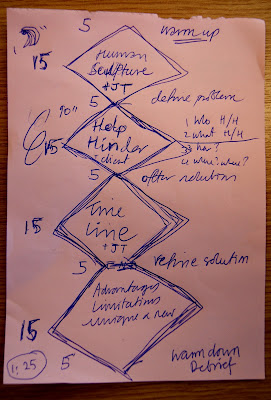Today’s Creative Problem Solving workshop went well.
Why?

I planned, but didn’t over plan. I kept it simple, doing a combination of what I know, what I’ve done or had done to me, with an intuitive inclination to two straightforward exercises that I stumbled upon in the B822 Techniques Library: ‘Advantages, Limits and Unique Qualities’ is the first exercise in the book. This sounded like my people, something they’d be familiar with. That they could do. I had it down as an opening exercise, then rejigged it to the end of the cession to assess our plan of action. Then there was Help/Hinder, I’m glad to say a ‘pure OUBS’ exercise as if was devised by Jane Henry and John Martin in 1997 for the Creative Problem-solving Guide.

It helps that
a) I am a professional (though part time) swimming coach.
b) As a director, often working with members of the public of client members of staff, I can give clear direction and put people at their ease
It matters enormously when you stand up in front of 10, 20 sometimes 60 young athletes that you know, to the minute what you want to do (and know why it has to be done). It matters to your assistant coaches too. This isn’t so different. I will be on my feet for 90 minutes (a senior squad group runs 2 hours, the junior swimmers an hour). A handwritten plan might suffice, often put into a day per page diary. This gets written up on a large whiteboard poolside. With swimmers this is very much for them to see bit by bit what is expected of them, but it also provides for the stressed-out coach with a million things on their mind with an immediate aide memoire. Swimmers perform to the second. At the top level we expect them to swim within the tinniest of tolerances, hitting during training a specific, personal time of Personal Best (PB) + a number of seconds. The expert amongst them do it.
I digress.
This was a different kind of class entirely. Adult swimmers, I could say. Not a group of unknowns though, with strangers I may have thrown them in a the deep end, but I knew with my colleagues that resting their legs in the water, a Jacuzzi perhaps or floating around in the shallow end would be enough. I was right, finger-painting, super-hero role play, or hypnosis would have been the equivalent of Mr Bean on the High Diving Board.
It would be egalitarian, whatever their position (we had directors, managers and officers). In this respect, I would have to take it carefully, advancing them into exercises and responding as they do. In practice each planned exercise came off and with care I kept people engaged in what I wanted them to do, even where I sensed they were feeling a little uncomfortable.
Laughter in the warm-up exercise helped.
WARM UP
It felt appropriate as someone they know to be a swimming coach to do a short ‘poolside’ swimming related practical. My initial thought had been ‘hot potato’ a version of what we did at Residential School and I see trotted out all the time, the throw the ball, say your name add an adjective pass it on. Exactly what I do with young swimmers as they join a squad for the first time and will soon be competing together. In this case, with one exception everyone knew each other very well. To begin to form a bond between strangers yes.
To teach sculling I get swimmers to place their hands on their face, look at the shape of their hands, then describe ‘infinity’ elbows in hands in front of them. They did a bit of this and I added floating off the bottom of the pool, making whirlpools and polishing a bald man’s head.
We did Samurai Mother-in-law, Tiger in a Tutorial. I felt a quick team go of Paper, Scissors, Stone would be a valuable intermediary step. I can see now that I have this set of steps I want them to take with me, and that I have to be the judge of how to place the ‘stones’. Here I am still looking for an easy buy in.
Team Game : Paper Scissors Stone
Two goes at this and we were ready for the next one.
Team Game : Samurai Mother-in-law, Tiger
The first of these drew laughter, the second fits of giggles. I don’t know what the scores were and didn’t want to start thinking about doing it often enough to find a winning team so swiftly moved on.
(More to follow once I have extracted the confidential or the controversial)